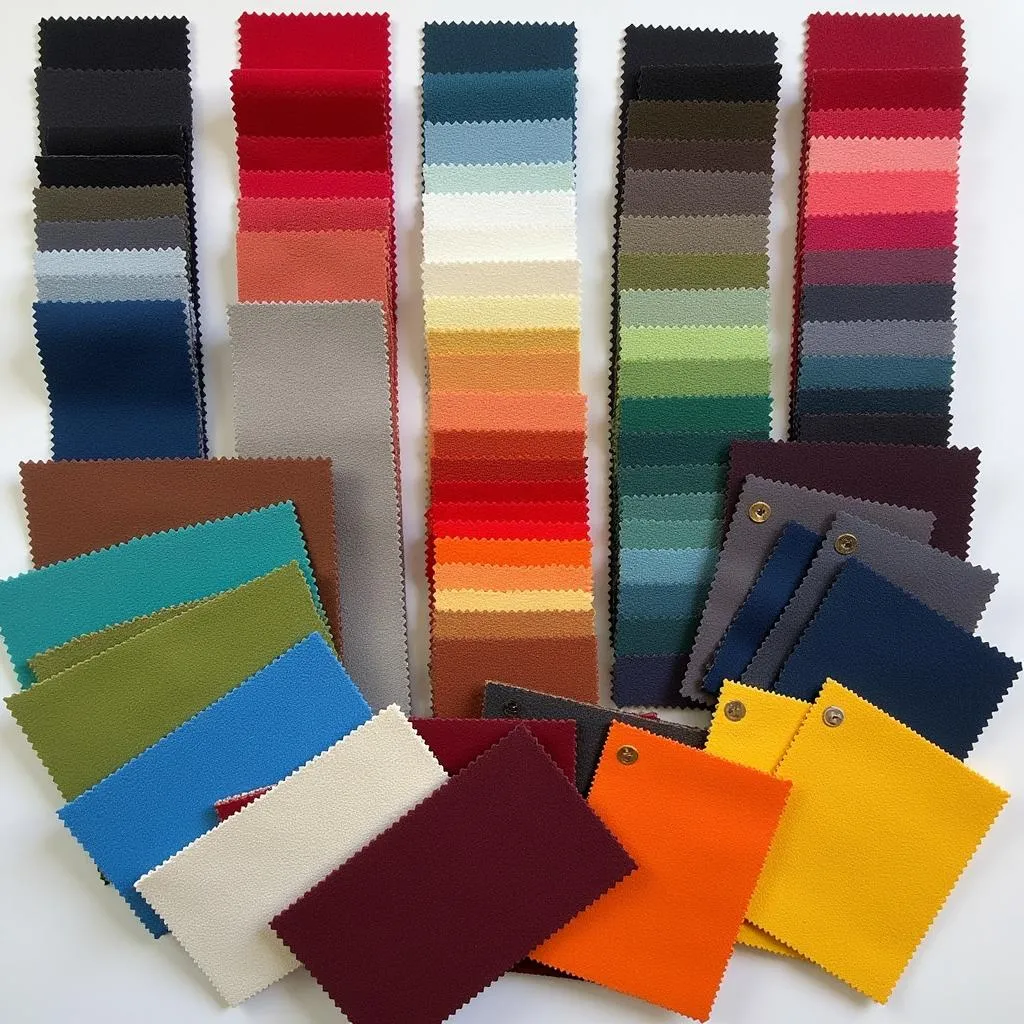Changing the color of your car’s interior is a great way to personalize your ride and make it truly your own. Whether you’re tired of the same old beige or want to match your car’s exterior, a color change can breathe new life into your vehicle. But where do you begin? Don’t worry, we’ll guide you through every step of transforming your car’s interior.
Planning Your Car Interior Color Change
Before diving into the exciting world of color swatches, let’s lay the groundwork for a successful transformation.
1. Setting a Realistic Budget
Changing your car’s interior color isn’t as simple as a quick paint job. It involves materials, tools, and potentially professional labor. Define your budget early on to determine what’s achievable.
2. Choosing the Right Color
This is where your personal style shines! Consider your car’s exterior color and your own preferences. Do you envision a sleek, monochromatic look or a bold contrast?
 Car Interior Color Palette
Car Interior Color Palette
3. DIY or Professional Help?
Are you a hands-on enthusiast or prefer leaving it to the experts? Assessing your skill level is crucial. While some tasks are manageable, others require specialized knowledge and tools.
Materials and Tools for Car Interior Color Change
Now that you have a vision, let’s gather the essentials.
- Cleaning Supplies: A spotless interior is key for proper paint adhesion.
- Sandpaper: Different grits will be needed for prepping surfaces.
- Primer: This ensures the paint adheres evenly.
- Automotive Interior Paint: Opt for high-quality, flexible paint designed for vinyl, plastic, and leather.
- Paint Brushes, Rollers, and Spray Guns: Choose the right tools based on the surfaces you’re painting.
- Masking Tape and Plastic Sheeting: Protect areas you don’t want to paint.
Step-by-Step Guide to Changing Your Car Interior Color
Ready to get your hands dirty? Let’s get started!
- Thorough Cleaning: Remove all dust, dirt, and grime from your car’s interior.
- Disassemble Interior Components: Carefully remove seats, door panels, dashboard trim, and any other parts you’ll be painting.
- Surface Preparation: Sand down surfaces to create a smooth base for paint adhesion.
- Masking: Use masking tape and plastic sheeting to protect areas you don’t want to paint.
- Priming: Apply a primer evenly to all surfaces being painted.
- Painting: Follow the paint manufacturer’s instructions for application and drying times. Apply multiple thin coats for the best finish.
- Reassembly: Once the paint is completely dry, carefully reassemble all interior components.
 Painting Car Door Panel
Painting Car Door Panel
Tips for a Professional-Looking Finish
- Patience is Key: Rushing the process can lead to mistakes. Take your time for the best results.
- Proper Ventilation: Work in a well-ventilated area to avoid inhaling paint fumes.
- Test on a Hidden Area: Before committing to a color, test the paint on a small, inconspicuous area.
- Consider Professional Help: For complex jobs or if you’re unsure about a step, seeking professional help can save you time and frustration.
Conclusion
Changing the color of your car’s interior is an exciting way to add a personal touch and enhance your driving experience. While it requires careful planning and execution, the end result is a unique and stylish interior that reflects your personality. With the right tools, materials, and a bit of patience, you can transform your car’s interior into a space you truly love.
FAQs
1. Can I change the color of any car interior?
Yes, most car interior materials can be painted, including vinyl, plastic, and leather. However, some materials might require specific types of paint or preparation.
2. How long does it take to change a car interior color?
The time required depends on the complexity of the job and the chosen method. DIY projects can take a few days to a week, while professional work might be completed faster.
3. What type of paint is best for car interiors?
Use high-quality automotive interior paint that’s specifically designed for the materials you’re painting. Flexible paints are ideal for surfaces that are prone to movement or temperature changes.
4. How can I ensure a smooth paint finish?
Thorough surface preparation is crucial. Sanding and priming create a smooth base for the paint to adhere to, preventing peeling or cracking later on.
5. Can I change the color of my car’s leather seats?
Yes, you can dye or paint leather car seats. However, working with leather requires specific products and techniques, so research thoroughly or consider professional help.
6. How do I protect my new car interior color?
Use car interior protectants to shield the new finish from UV rays, spills, and everyday wear and tear. Regular cleaning also helps maintain the color and vibrancy.
7. What are some popular car interior color combinations?
Popular choices include black and red for a sporty feel, beige and brown for a classic look, or gray and blue for a modern aesthetic.
Do you have other questions about car customization or home design? Check out these related articles:
- What color do diamonds sparkle: Curious about the dazzling world of diamonds and their captivating sparkle? Discover the secrets behind their brilliance and how color plays a role.
- Can you change Tesla color after order: Thinking of switching up your Tesla’s look? Learn about the possibilities and limitations of changing your Tesla’s color after placing an order.
- [Should you paint ceilings the same color as walls](https://colorbox.com.vn/should-you-paint-ceilings-the same-color-as-walls/): Explore the design possibilities of painting your ceilings and walls the same color. Discover the impact on your space and get inspired to transform your home.
- How to coordinate paint colors throughout house: Create a cohesive and harmonious home by mastering the art of coordinating paint colors throughout your living spaces.
- Do it best paint color samples: Discover the world of Do it Best paint color samples and find the perfect hues to bring your home design vision to life.
For expert advice and personalized assistance with your car interior color change or any other design project, contact our team at Color Box Hanoi.
Call us at: 0373298888
Email us at: [email protected]
Visit us at: 86 Cầu Giấy, Hà Nội
Our dedicated team is available 24/7 to answer your questions, offer expert guidance, and help you create the car interior of your dreams.

